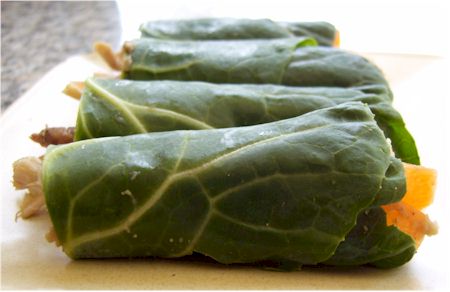![]() How much calcium we really need is a topic for another day. The fact of the matter is, many people are in hot pursuit of calcium, and they fear that a milk-free diet will leave them void. A recent article from Care2Health proclaimed that in terms of calcium, “Collard Greens Have More than Milk.” So is this true? Could greens actually be a good bone-building source? Yes and no, and yes. Let me explain.
How much calcium we really need is a topic for another day. The fact of the matter is, many people are in hot pursuit of calcium, and they fear that a milk-free diet will leave them void. A recent article from Care2Health proclaimed that in terms of calcium, “Collard Greens Have More than Milk.” So is this true? Could greens actually be a good bone-building source? Yes and no, and yes. Let me explain.
According to the Harvard School of Public Health, 1 cup of collard greens contains 357 mg of calcium versus 306 mg of calcium in dairy milk. But the article fails to mention that this is 1 cup of cooked collards (nor do they mention the weight of their 1 cup). That is a lot of green for anyone to choke down, considering an entire bunch of collard green leaves can widdle down to 1/2 cup once cooked. So it may not be realistic for many people to expect to consume that much calcium from collard greens. Also the reports of “how much” calcium seem to vary widely. The USDA nutrition database states that 1 cup of cooked collards (weighing in at 190 grams or 6.7 ounces) contains 266mg of calcium, while 1 cup of raw collards (weighing in at 36 grams or 1.3 ounces) contains 52mg of calcium.
But, those big leaves do have more to offer our bones than just calcium. Yes, even 1/2 cup of cooked collards (or 2 cups of raw) would be considered a great source of calcium, but you will also get a good dose of Vitamin K.
Another blip from those folks at Harvard, “Vitamin K, which is found mainly in green, leafy vegetables, likely plays one or more important roles in calcium regulation and bone formation. Low levels of circulating vitamin K have been linked with low bone density …” Collard Greens are an excellent source of Vitamin K, along with a host of other great vitamins and minerals. And, as the people at Cooking Light point out, Kale has similar bone-building benefits.

To note – Kale actually has a higher absorption rate of calcium (our bodies are able to use more of it per mg) than milk!
Okay, there is just one more issue – taste. I love Swiss chard, spinach, romaine, and other neutral tasting greens, but those really dark leaves, like kale and collards are often a bit bitter for my taste buds. Nonetheless, I do find them enjoyable when paired with different flavors to counteract their bitterness. I make a carrot, purple cabbage, and kale saute with a touch of maple for a truly award-winning cooked salad. And as for those collards, they are new to me (as a Northwesterner, I didn’t grow up with collard greens, but they keep appearing in my CSA!), but I am experimenting and have found some great recipes to look forward to:
- Collard Wraps with Sunflower Seed Pate
- Collard Greens and Hummus Mini-Wraps
- 5-Star Garlic Simmered Collard Greens
- Vegan Collard Green Tamales
- Martha’s Sauteed Collard Greens w/ Raisins
- Billy’s Favorite Smoky Collard Greens
- Collard Green Slaw

If you have Kale to experiment with, trial one of these dairy-free recipes:
- Averie’s Raw Cheesy Kale Chips
- Kalyn’s Sea Salt and Vinegar Kale Chips
- Kale and Sweet Potato Salad w/ Warm Bacon Dressing
- Collard-Style Kale and Shiitake Mushrooms
To comment on this article with a question, greens recipe recommendation, or with additional notes, see this post on Dairy Free & Fit.
For more information on building healthy bones, including calcium charts, nutritional studies, and more, see the Calcium and Strong Bones chapter in my book, Go Dairy Free.
Article by Alisa Fleming, founder of GoDairyFree.org and author of Go Dairy Free: The Guide and Cookbook for Milk Allergies, Lactose Intolerance, and Casein-Free Living. In addition to her own dairy-free lifestyle, Alisa has experience in catering to the needs of various special diets, including gluten-free, soy-free, egg-free, vegan, and multiple food allergies. Need Go Dairy Free now? Order the E-Book for immediate delivery or download it to your Kindle

3 Comments
please share the research paper that indicates the percentage of calcium absorbed from collard greens vs milk.
Of course. Here is the one we were referencing – https://pubmed.ncbi.nlm.nih.gov/2321572/
The 357 amount of calcium is from frozen collard greens.